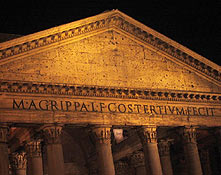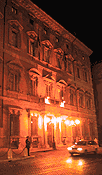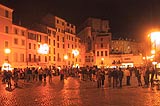
PANTHEON
IN ROME |
PANTHEON,
SAN LUIGI DEI FRANCESI, PALAZZO MADAMA and NAVONA SQUARE
This
itinerary surely is one of the most fascinating of Rome by night
as it touches some of the most popular places of interest such as
Navona Square and will immerse you in the most fascinating and joyful
atmosphere of the eternal city. Starting from the famous temple
Pantheon dedicated to Marco Agrippa, Augusto's son-in-law and lieutenant,
it will lead you through narrows streets in the historical center
of Rome till Campo dei Fiori, the centre of the Roman nightlife,
where it's possible to have a good glass of wine or a traditional
dinner in one of the several restaurants and wineries scattered
in the area.
The Pantheon is one the most well conseved monument of the ancient
Rome as it's been transformed in a church during the medieval time
by the Vatican. Pantheon dome has been for long time the biggest
in the world till the moment it was built Santa Maria del Fiore
in Florence. The columns of the facade substain a pediment with
an inscription attributing the Pantheon to Marcus Agrippa even if
it was built by Emperor Hadrian in 118 AD. This is becouse first
pantheon was really based on Agrippa's project but it completely
burnt in 80 A.D., then rebuilt by Domitian and once again burnt
as struck by lightning. Emperor Adriano then constructed it with
an original shape and lines. Visit the interior is a must as here
are buried famous painter Raffaello and some kings of Italy such
as Victor Emmanuel II, to whom was

PANTHEON IN ROME |
also dedicated the Vittoriano.
Just behind the Pantheon there's Santa Maria sopra Minerva's obelisk,
a Bernini's work, composed by an elephant sormounted by an original
egyptian obelisk of the VI cent. B.C., representing the Chrstian
virtues leading to the wisdom.
From the Pantheon walking "Via Giustiniani" through a
series of shops selling every kind of titbit you'll be in a while
in front of San Luigi dei Francesi Church, the National French Church
built on a project by Giacomo della Porta and Carlo Fontana in obedience
to King of France's will. The church is a must for those who like
the Caravaggio as it kept three paintings of him: San Matteo
e l'Angelo, the Vocazione di San Matteo and Martirio
di San Matteo, all painted for the Contarelli Chapel for the
jubilee year of 1600.
In the same street is also present Palazzo Madama, Italian Senate
Seat. This palace was the Medici's Residence in Rome and hosted
also Giovanni and Giuliano de' Medici. The first became Pope Leone
X in 1513 and was Lorenzo de' Medici's son. The second became Pope
Pope Clemente VII in 1523 and was born to Giuliano, Lorenzo de'
Medici's brother who was murdered in the famous Pazzi conspiracy.
The name of the palace is due to Madame Margherita d'Austria, Emperor
Charles V's son, who married Alessandro de' Medici, Clemente VII's
son.
Carrying on with this itinerary through Via del Salvatore you'll
reach famous Navona Square, one of the center of nightlife in Rome.
Navona Square immediately impresses the visitor both for its size
and fountains all projected in XVI century but the Four Rivers Fountain
that is a Bernini's project. Evocative aspect of this beautiful
place is the origin of its geometry: it was exactly drawn following
the perimeter of Domitian's Stadium built in 86 AD, hence its shape.
The stadium known as 'Circus Agonalis' was mainly used for horses'
races. The name of the sqaure seems to derive from the changement
of the name of the stadium in 'in agone' to 'navone' and finally
to 'navona'. The image of this place is strongly linked to its particular
shape and the presence of the three fountains, one in the north,
one in the middle and the last in the south of the square. Two of
these are Bernini's works: the southern "Fontana del Moro"
(1653) and the central "Fontana dei Quattro Fiumi",
| CLICK
IMAGES TO ENLARGE THEM |
 SANTA
MARIA
SANTA
MARIA
MINERVA OBELISK |
 INSCRIPTION
ON THE PEDIMENT
INSCRIPTION
ON THE PEDIMENT
- M AGRIPPA L F COSTERTIUM FECIT - |
 PALAZZO
MADAMA
PALAZZO
MADAMA
SENATE SEAT |
 BERNINI'S
BERNINI'S
FOUNTAIN |
a real baroque masterpiece wanted by Pope Innocenzo X, Bernini and
Borrmoni's patron, and inaugurated in 1651. This mouments is an
allegorical image of the pacification role that Innocenzo X intended
to have toward the entire known world. Hance four rivers represent
four continents: Danubio for Europe, Gange for Asia, Nile for Africa
represented with a blindfold as its sprimgs were unknown yet, Rio
de la Plata represented by a Negro with some coins on the base representing
the richness of Americas. In the middle a big rock sourmounted by
an obelisk, a roman copy dates back to I cent, and a pigeon on the
top, both symbol of peace and Pope Innocenzo X's family. Finally
the message is clear: The entire world pacificated  under
the guide of Pope Innocenzo X. The closeness are one of the most
interesting area of Rome for the baroque period but we leave you
discover by yourslves the palaces and the curiosities of this area
as we want to take you to meet a rela tidbit: the Pasquino's Statue. under
the guide of Pope Innocenzo X. The closeness are one of the most
interesting area of Rome for the baroque period but we leave you
discover by yourslves the palaces and the curiosities of this area
as we want to take you to meet a rela tidbit: the Pasquino's Statue.
This statue was brought here in 1501 and suddenly it started to
talk to the population. Pasquino's statue took its name from a cobler
who had been working close to here in XVI cent. As right of thinking
was not easy to achieve in the ancient Rome governed by Popes, Pasquino
used to attached to the basement of this statue his political and
social complaining and soon was imitated by the rest of the population.
Still today is possible to see and read ironical complaining to
the Italian Government. |